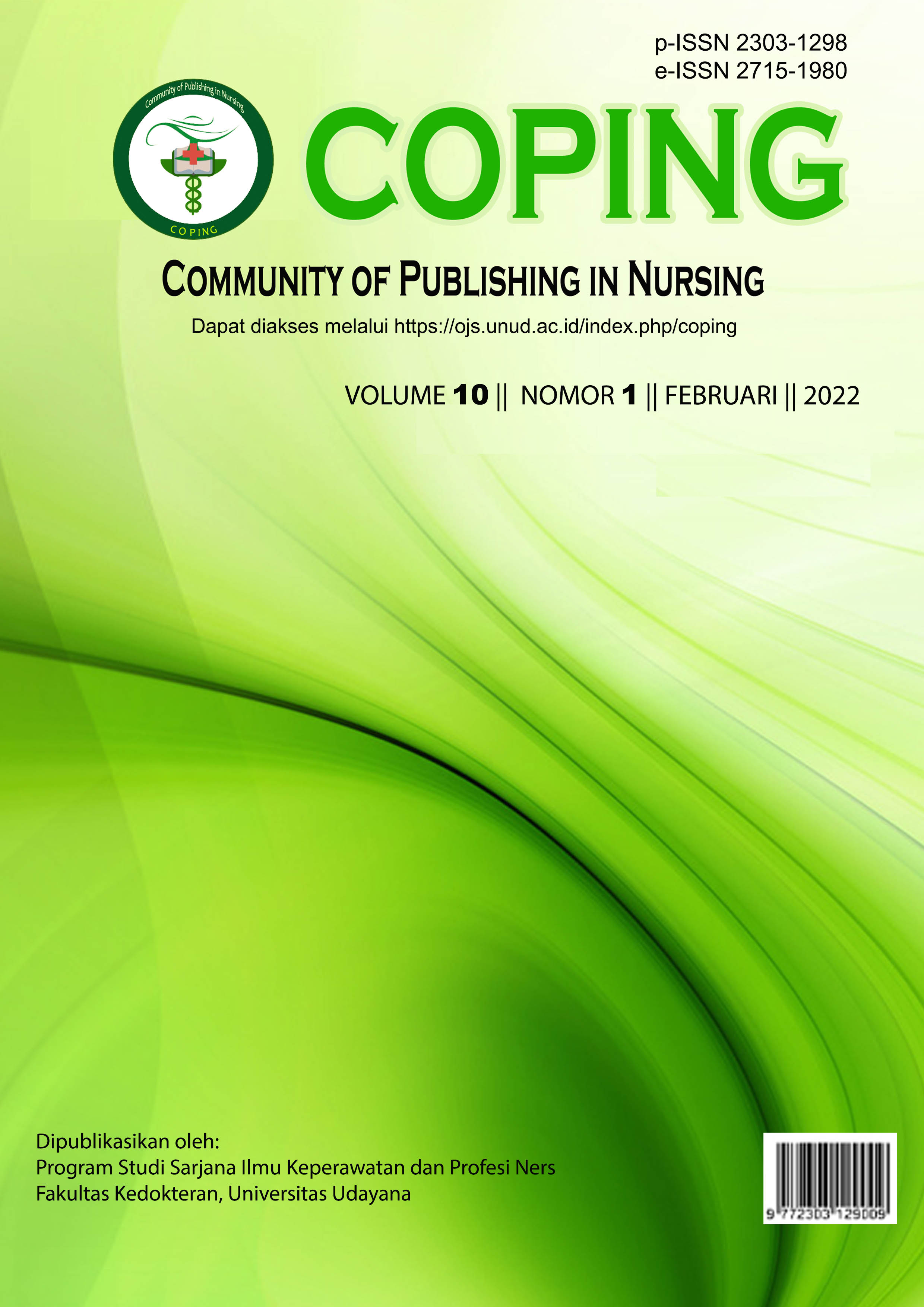HUBUNGAN KEJADIAN SEPSIS BERDASARKAN SKOR PEDIATRIC SEQUENTIAL ORGAN FAILURE ASSESSMENT (PSOFA) DENGAN MORTALITAS PADA PASIEN ANAK
Abstract
Sepsis memiliki angka kejadian hingga 25% dari pasien yang masuk ke PICU. Penelitian ini bertujuan untuk mengetahui hubungan kejadian sepsis berdasarkan skor Pediatric Sequential Organ Failure Assessment (PSOFA) dengan mortalitas pada pasien anak yang dirawat di PICU. Desain penelitian adalah studi retrospektif dengan teknik purposive sampling. Sampel berjumlah 89 responden dengan kriteria inklusi yaitu usia 1 bulan-17 tahun, lama tinggal PICU >24 jam, hasil laboratorium lengkap, sedangkan kriteria eklusi yaitu pasien penyakit kronis dengan keganasan, kelainan hematologi, jantung, paru, ginjal bawaan dan data hasil laboratorium tidak dapat terbaca. Analisa dilakukan dengan analisis bivariat uji chi-square. Mayoritas responden berjenis kelamin laki-laki 57 responden (64%), usia infan (0-11 bulan) 33 responden (37,1%), lama rawat ?3 hari 64 responden (71,9%) dan distribusi responden menurut diagnosis medis postsurgical recovery 37 responden (41,6%), mayoritas sepsis 45 responden (50,6%) dan keluar PICU dengan kondisi hidup 74 responden (83,1%). Hasil analisis bivariat diperoleh nilai p value= 0,001 lebih kecil dari nilai alpha 0,05 (p value < ?). Terdapat hubungan yang signifikan antara kejadian sepsis berdasarkan Pediatric Sequential Organ Failure Assessment (PSOFA) dengan mortalitas. Skor PSOFA dapat digunakan sebagai metode deteksi sepsis guna memprediksi mortalitas pada anak.
Downloads
References
Biruh T Workeneh, Mahendra Agraharkar, & Rajiv Gupta. (2020, December 24). Acute Kidney Injury: Practice Essentials, Background, Pathophysiology. Retrieved July 8, 2021, from https://emedicine.medscape.com/article/243492-overview#a7
Brooten, D., Youngblut, J. A. M., Caicedo, C., Seagrave, L., Patricia Cantwell, G., & Totapally, B. (2016). Cause of death of infants and children in the intensive care unit: Parents’ recall vs chart review. American Journal of Critical Care, 25(3), 235–242. https://doi.org/10.4037/ajcc2016233
Chamberlain, D., Willis, E., & Bersten, A. (2011). The severe sepsis bundles as processes of care: a meta-analysis. Australian Critical Care : Official Journal of the Confederation of Australian Critical Care Nurses, 24(4), 229–243. https://doi.org/10.1016/J.AUCC.2011.01.003
Deutschman, C. S., & Tracey, K. J. (2014). Sepsis: current dogma and new perspectives. Immunity, 40(4), 463–475. https://doi.org/10.1016/j.immuni.2014.04.001
Dewi, R., Christie, C. D., Wardhana, A., Fadhilah, R., & Pardede, S. O. (2019). Pediatric logistic organ dysfunction-2 (PELOD-2) score as a model for predicting mortality in pediatric burn injury. Annals of Burns and Fire Disasters, 32(2), 135–142.
Dorofaeff, T., Mohseni-Bod, H., & Cox, P. N. (2012). Infection in the PICU. In Textbook of Clinical Pediatrics. https://doi.org/10.1007/978-3-642-02202-9
Fajrina, R. (2016). Analisis trombositopenia sebagai faktor risiko kematian pasien sepsis di rsudza banda aceh. Surgical Infections-Medicine Septicemia.
Gogia, P., & Prasad, S. (2016). Utility of sequential organ failure assessment score in prognosticating sick children in pediatric intensive care unit. International Journal of Contemporary Pediatrics, 3(4), 1193–1196. https://doi.org/10.18203/2349-3291.ijcp20163514
Ha, E. J., Kim, S., Jin, H. S., Bae, K. W., Lim, H. J., Seo, J. J., & Park, S. J. (2010). Early changes in SOFA score as a prognostic factor in pediatric oncology patients requiring mechanical ventilatory support. Journal of Pediatric Hematology/Oncology, 32(8), e308–e313. https://doi.org/10.1097/MPH.0b013e3181e51338
Hudak, C. M., & Gallo, B. M. (2012). Keperawatan kritis. Jakarta: EGC.
IDAI. (2016). Pelayanan emergensi, rawat intermediet dan rawat intensif anak. In Buku Panduan IDAI.
Iskandar, H. R., Mulyo, D., Pudjiadi, A., Pratiwi, A., & Suryatin, Y. (2011). Perbandingan pediatric logistic organ dysfunction dan pediatric risk of mortality III sebagai prediktor kematian sindrom syok dengue di ruang rawat intensif anak. Sari Pediatri, 12(6), 440. https://doi.org/10.14238/sp12.6.2011.440-6
Jui, J. (2011). Septic shock. New York: McGraw-Hil.
Kolovos, N. S. (2021). Multiple organ dysfunction syndrome. Pediatric Critical Care, 1086–1101. https://doi.org/10.1016/B978-1-4557-0306-7.00007-6
Matics, T. J., & Sanchez-Pinto, L. N. (2017). Adaptation and validation of a pediatric sequential organ failure assessment score and evaluation of the Sepsis-3 definitions in critically ill children. JAMA Pediatrics, 171(10), 1–9. https://doi.org/10.1001/jamapediatrics.2017.2352
Mianling, Z., Yuge, H., Tufeng, L., Lu, X., Ting, T., Miaofen, L., & Dongqiang, H. (2019). Performance of the pediatric sequential organ failure assessment score in assessing the prognosis of children with sepsis in a PICU of a developing country: a single-center retrospective observational study. Iranian Journal of Pediatrics, 29(5). https://doi.org/10.5812/ijp.89024
Mohamed El-Mashad, G., Said El-Mekkawy, M., & Helmy Zayan, M. (2020). Paediatric sequential organ failure assessment (pSOFA) score: a new mortality prediction score in the paediatric intensive care unit. Anales de Pediatria, 92(5), 277–285. https://doi.org/10.1016/j.anpedi.2019.05.018
Moseley, M., Sole, M. Lou, & Klein, D. (2009). Introduction to critical care nursing (8th ed.).
PPNI. (2016). Standar diagnosis keperawatan indonesia: definisi dan indikator diagnostik (1st ed.). Jakarta: DPP PPNI.
Sakr, C., Sphonholz, & K Reinhart. (2007). Organ dysfuntion in the ICU: a clinical perspective. In: Vincent JL (2007 Yearb). New York: Springer.
Schlapbach, L. J., Straney, L., Bellomo, R., MacLaren, G., & Pilcher, D. (2018). Prognostic accuracy of age-adapted SOFA, SIRS, PELOD-2, and qSOFA for in-hospital mortality among children with suspected infection admitted to the intensive care unit. Intensive Care Medicine, 44(2), 179–188. https://doi.org/10.1007/s00134-017-5021-8
Shapiro, N., Zimmer, G., & Barkin, A. (2012). Rosen’s emergency medicine concepts and clinical practice (8th ed.; P. Rosen, J. Marx, R. Hockberger, R. Walls, & M. Biros, Eds.). Philadelphia: Elsevier Saunders.
Shime, N., Kawasaki, T., & Nakagawa, S. (2017). Proposal of a new pediatric sequential organ failure assessment score for possible validation. Pediatric Critical Care Medicine, 18(1), 98–99. https://doi.org/10.1097/PCC.0000000000001009
Sianipar, N. B. (2014). Trombositopenia dan berbagai penyebabnya. Cermin Dunia Kedokteran, 41(6), 416–421.
Singer, M., Deutschman, C. S., Christopher, ;, Seymour, W., Shankar-Hari, M., Annane, D., … Angus, D. C. (2016). The third international consensus definitions for sepsis and septic shock (Sepsis-3). JAMA, 315(8), 801–810. https://doi.org/10.1001/jama.2016.0287
Sri, H. (2014). Gambaran faktor penyebab Infeksi Saluran Pernafasan Akut (ISPA) pada balita di Puskesmas Pasirkaliki Kota Bandung. Jurnal Ilmu Keperawatan, 11(1), 62–67. Retrieved from https://ejournal.bsi.ac.id/ejurnal/index.php/jk/article/view/137
Suwondo, A. (2014). Ilmu penyakit dalam (VI; S. Setiati, I. Alwi, A. W. Sudoyo, M. S. K, B. Setiyohadi, & A. F. Syam, Eds.). Jakarta: InternaPublishing.
Tambajong, R. N., Lalenoh, D. C., & Kumaat, L. (2016). Profil penderita sepsis di ICU RSUP Prof. Dr. R. D. Kandou Manadoperiode Desember 2014 – November 2015. E-CliniC, 4(1). https://doi.org/10.35790/ECL.V4I1.11011
Tutak, E., Ozer, A. B., Demirel, I., & Bayar, M. K. (2014). The relationship between serum bilirubin level with interleukin-6, interleukin-10 and mortality scores in patients with sepsis. Nigerian Journal of Clinical Practice, 17(4), 517–522. https://doi.org/10.4103/1119-3077.134057
Vogel, T. R., Dombrovskiy, V. Y., & Lowry, S. F. (2009). Trends in postoperative sepsis: are we improving outcomes? SURGICAL INFECTIONS, 10(1). https://doi.org/10.1089/sur.2008.046
Weiss, S. L., Fitzgerald, J. C., Pappachan, J., Wheeler, D., Jaramillo-Bustamante, J. C., Salloo, A., … Thomas, N. J. (2015). Global epidemiology of pediatric severe sepsis: the sepsis prevalence, outcomes, and therapies study. American Journal of Respiratory and Critical Care Medicine, 191(10), 1147–1157. https://doi.org/10.1164/rccm.201412-2323OC
Wulandari, A., Pudjiastuti, P., & Martuti, S. (2019). Severe sepsis criteria, PELOD-2, and pSOFA as predictors of mortality in critically ill children with sepsis. Paediatrica Indonesiana, 59(6), 318–324. https://doi.org/10.14238/pi59.6.2019.318-24
Yuliana, H., Deli, H., & Agrina, A. (2021). Hubungan Skor Modified Sequential Organ Failure Assessment (Msofa) Dengan Kejadian Ventilator Associated Pneumonia (Vap) Pada Pasien Yang Terpasang Ventilator. Jurnal Ners Indonesia, 11(2), 142. https://doi.org/10.31258/jni.11.2.142-153

This work is licensed under a Creative Commons Attribution-NonCommercial 4.0 International License.







